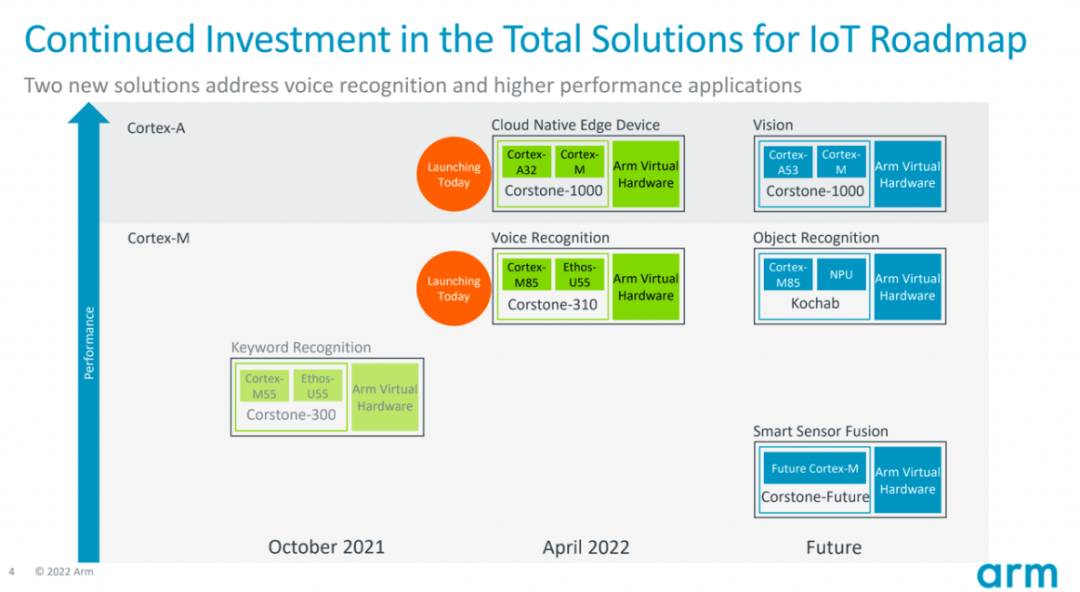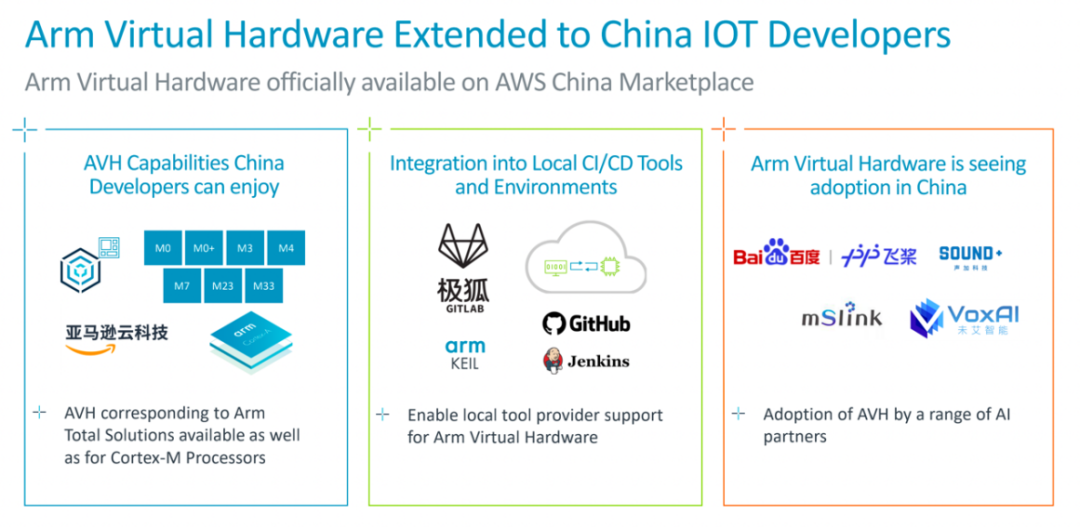
Author: Ada
IoT Think Tank Organized and Published
Introduction
Recently, Arm announced the expansion of its Total Solutions for IoT product roadmap and released two new solutions based on Arm® Cortex®-M and Cortex-A processors. In the past, people may have had a fixed impression of Arm based on its achievements in hardware and IP. However, last October, Arm launched a comprehensive IoT solution consisting of the Arm Corstone subsystem, Arm Virtual Hardware, and Project Centauri standards, simplifying development and accelerating product design by integrating hardware IP, platform software, machine learning (ML) models, tools, and more. Recently, Arm announced the expansion of its Total Solutions for IoT product roadmap and released two new solutions based on Arm® Cortex®-M and Cortex-A processors. Additionally, in this expanded product roadmap, Arm introduced the most powerful and secure Cortex-M processor to date, the Arm Cortex-M85, and extended Arm Virtual Hardware to include more platforms with third-party devices, making the development process simpler and smoother.
In the past, people may have had a fixed impression of Arm based on its achievements in hardware and IP. However, last October, Arm launched a comprehensive IoT solution consisting of the Arm Corstone subsystem, Arm Virtual Hardware, and Project Centauri standards, simplifying development and accelerating product design by integrating hardware IP, platform software, machine learning (ML) models, tools, and more. Recently, Arm announced the expansion of its Total Solutions for IoT product roadmap and released two new solutions based on Arm® Cortex®-M and Cortex-A processors. Additionally, in this expanded product roadmap, Arm introduced the most powerful and secure Cortex-M processor to date, the Arm Cortex-M85, and extended Arm Virtual Hardware to include more platforms with third-party devices, making the development process simpler and smoother.
“The Latest, Fastest, and Most Secure Cortex-M Processor”
As stated by Mohamed Awad, Vice President of Arm’s IoT and Embedded Division, developers are driving the future of IoT, but in the face of increasing demands, they also need stronger performance, higher security, and simpler development processes. In response, Arm launched a cloud-native edge device solution and a voice recognition solution, significantly expanding the Arm Virtual Hardware library, including support for third-party devices and most of the Cortex-M product line.
 Among them, Arm’s cloud-native edge device solution is the first product designed for Cortex-A and based on Corstone-1000. It allows IoT developers to use operating systems like Linux for the first time, enabling application-level workload development on smart wearable devices, gateways, and high-end smart cameras. The Arm voice recognition solution is based on the Corstone-310 subsystem. It pre-integrates the new Cortex-M85 and Arm Ethos™-U55, making it Arm’s highest performance MCU-level processor to date. This solution targets use cases such as smart speakers, thermostats, drones, and factory robots. Developers can also combine Corstone-310 with various reference software to develop a wide range of high-performance products. Notably, the Cortex-M85 is referred to by Mohamed Awad as “Arm’s latest, fastest, and most secure Cortex-M processor,” featuring Arm Helium technology to support end-device machine learning and DSP workloads. It is also the first Cortex product to integrate Pointer Authentication and Branch Target Identification (PACBTI) from the Arm-v8.1M architecture, significantly enhancing security. Mohamed Awad stated that as IoT continues to evolve, microcontroller software developers wish to add more features and “intelligence” to their products, facing significant challenges in product design. They need to extract more processing power from current microcontrollers in every clock cycle or choose to forgo features, neither of which is a good option. Additionally, the increasingly severe security issues in IoT have become a “shackle” for developers. The Cortex-M microcontroller series offers low interrupt latency, advanced low-power management modes, and security features based on TrustZone, with the Cortex-M85 being the most advanced product, making it an ideal choice for applications with additional performance and security requirements. Compared to the previous generation Cortex-M7, the Cortex-M85 has improved traditional workload performance by 30%. The Cortex-M85 also shows a 20% improvement in machine learning performance over the Cortex-M55. Compared to the M7 and M55, the Cortex-M85 can provide high traditional performance and machine learning performance simultaneously, making it applicable across various applications. Mohamed Awad expects that Arm partners will gradually release Cortex-M85-based chip products in 2022.
Among them, Arm’s cloud-native edge device solution is the first product designed for Cortex-A and based on Corstone-1000. It allows IoT developers to use operating systems like Linux for the first time, enabling application-level workload development on smart wearable devices, gateways, and high-end smart cameras. The Arm voice recognition solution is based on the Corstone-310 subsystem. It pre-integrates the new Cortex-M85 and Arm Ethos™-U55, making it Arm’s highest performance MCU-level processor to date. This solution targets use cases such as smart speakers, thermostats, drones, and factory robots. Developers can also combine Corstone-310 with various reference software to develop a wide range of high-performance products. Notably, the Cortex-M85 is referred to by Mohamed Awad as “Arm’s latest, fastest, and most secure Cortex-M processor,” featuring Arm Helium technology to support end-device machine learning and DSP workloads. It is also the first Cortex product to integrate Pointer Authentication and Branch Target Identification (PACBTI) from the Arm-v8.1M architecture, significantly enhancing security. Mohamed Awad stated that as IoT continues to evolve, microcontroller software developers wish to add more features and “intelligence” to their products, facing significant challenges in product design. They need to extract more processing power from current microcontrollers in every clock cycle or choose to forgo features, neither of which is a good option. Additionally, the increasingly severe security issues in IoT have become a “shackle” for developers. The Cortex-M microcontroller series offers low interrupt latency, advanced low-power management modes, and security features based on TrustZone, with the Cortex-M85 being the most advanced product, making it an ideal choice for applications with additional performance and security requirements. Compared to the previous generation Cortex-M7, the Cortex-M85 has improved traditional workload performance by 30%. The Cortex-M85 also shows a 20% improvement in machine learning performance over the Cortex-M55. Compared to the M7 and M55, the Cortex-M85 can provide high traditional performance and machine learning performance simultaneously, making it applicable across various applications. Mohamed Awad expects that Arm partners will gradually release Cortex-M85-based chip products in 2022.
Arm Virtual Hardware Launched in China
Last October, Arm launched cloud-based Arm Virtual Hardware, which provides virtual models of the Corstone subsystem, allowing software development without relying on physical chips, bringing a modern agile software development approach to IoT and embedded platforms, including Continuous Integration/Continuous Development (CI/CD), DevOps, and MLOps, eliminating the need for investment in complex hardware farms. By providing accurate models based on Arm architecture SoCs, it simulates memory and peripheral mechanisms, allowing software development and testing to begin before the chip is fully available, thus reducing the typical product design cycle from an average of five years to as little as three years.
Now, nearly half a year has passed, and Arm Virtual Hardware has undergone industry refinement and received extensive feedback from developers. Firstly, developers appreciate being able to write software for hardware before it is available, and they also wish to access and extend their software across billions of IoT devices in the field. Secondly, developers want to integrate Arm Virtual Hardware into their preferred development processes while ensuring that their processes remain unchanged, and they prefer to integrate Arm Virtual Hardware directly into their existing tools and services that they use daily. Finally, in China, the ecosystem requires local support, so developers want to ensure that Arm Virtual Hardware targets are easily accessible and that local AI partners can easily access and utilize the technology. In response, Arm has also added several new virtual devices to enhance the appeal of Arm Virtual Hardware, including Arm Virtual Hardware designed for the new Corstone designs and Arm Virtual Hardware covering seven Cortex-M processors from Cortex-M0 to Cortex-M33. Additionally, Arm is further expanding its technology library with third-party hardware from partners such as NXP Semiconductors, STMicroelectronics, and Raspberry Pi.  By extending Arm Virtual Hardware to ecosystem devices and the vast majority of Cortex-M products, independent software vendors and cloud service providers can now leverage the tens of billions of deployed Arm architecture-based IoT and embedded devices. Meanwhile, Arm Virtual Hardware has officially launched in China, and Chinese developers can access this service through the Amazon Web Services Marketplace (China). Currently, domestic companies such as Baidu, VoicePlus Technology, and Weiyai Intelligent have become AI partners of Arm Virtual Hardware. According to Zhao Qiao, head of the PaddlePaddle product team at Baidu, “In the era of IoT, the efficient integration of deep learning open-source platforms with chip design platforms will greatly enhance the efficiency of industry developers in developing intelligent devices. By deeply integrating the PaddlePaddle industry-grade model library and inference capabilities with the Arm Virtual Hardware platform, developers can quickly and efficiently deploy the most popular PP series industry-grade feature models from GitHub onto Cortex-M series hardware in the cloud without completing the chip, rapidly completing AI small system prototype verification.”
By extending Arm Virtual Hardware to ecosystem devices and the vast majority of Cortex-M products, independent software vendors and cloud service providers can now leverage the tens of billions of deployed Arm architecture-based IoT and embedded devices. Meanwhile, Arm Virtual Hardware has officially launched in China, and Chinese developers can access this service through the Amazon Web Services Marketplace (China). Currently, domestic companies such as Baidu, VoicePlus Technology, and Weiyai Intelligent have become AI partners of Arm Virtual Hardware. According to Zhao Qiao, head of the PaddlePaddle product team at Baidu, “In the era of IoT, the efficient integration of deep learning open-source platforms with chip design platforms will greatly enhance the efficiency of industry developers in developing intelligent devices. By deeply integrating the PaddlePaddle industry-grade model library and inference capabilities with the Arm Virtual Hardware platform, developers can quickly and efficiently deploy the most popular PP series industry-grade feature models from GitHub onto Cortex-M series hardware in the cloud without completing the chip, rapidly completing AI small system prototype verification.”
Conclusion
As the IoT industry deepens and flourishes, the markets it serves are continuously expanding. In response to the diversified needs of the industry, Arm, as a global leader in semiconductor IP and one of the first semiconductor companies to layout IoT, is leveraging its inherent advantages in the IoT chip field to arrive at the starting point of a new era in IoT—an era where software and hardware are truly co-designed at the system level. With the support of Arm Virtual Hardware and high-performance processors, Arm is poised to lead a new wave of disruptive innovation.

